WORLD CLASS COACHING
Developing Soccer Intelligence Through 4v4 Vol 3
By Philip Cauchi
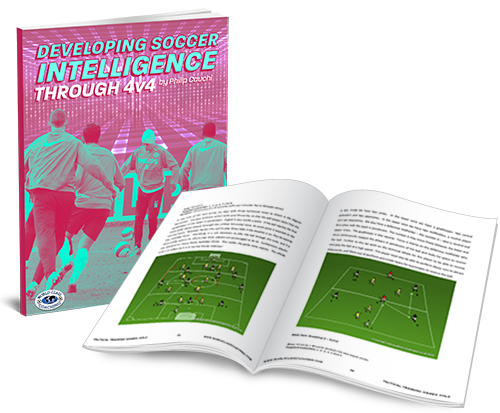
Table of Contents
PART ONE
Progressive Sessions
PART TWO
Progressive Sessions
PART THREE
Progressive Sessions
PART FOUR
Progressive Sessions
Progressive Sessions
Session number: 12.
Moment of the game: In possession.
Team task: Build-up.
Aim: Create and exploit the space to play forward.
Technical-tactical outcomes:
1. Staggered angles.
2. Move into passing lanes.
3. Open body stance to receive the ball.
4. Have width to stretch and create gaps in the defence.
5. Look to play vertically.
6. Support the vertical pass.
Duration of session: 85 to 90 minutes.
Number of players: 16 outfield players and no goalkeepers.
Equipment:
Bibs – one set of eight.
Markers – to mark pitch dimensions and zones.
Mannequins – two in each setup. These can also be substituted with cones.
Session plan:
1. Movement preparation and coordination: 15 minutes.
2. Technical-tactical activation – Triangular passing combinations: 10 minutes.
3. Positional play – 2v2+4 play to the target: 10 minutes.
4. Positional play – 3v3+2 support the forward pass: 10 minutes.
5. Small sided game – 3v3+2 target players on retracted goals with no goalkeeper: 20 minutes.
6. Conclusion and recapitulation: 5 minutes.
Movement preparation and coordination.
1. Running mechanics using the agility ladder – 10 minutes.
2. Mobility and dynamic stretching – 5 minutes.
3. Reactive sprints – 5 minutes (six repetitions each player).
Technical-tactical activation – Triangular passing combinations.
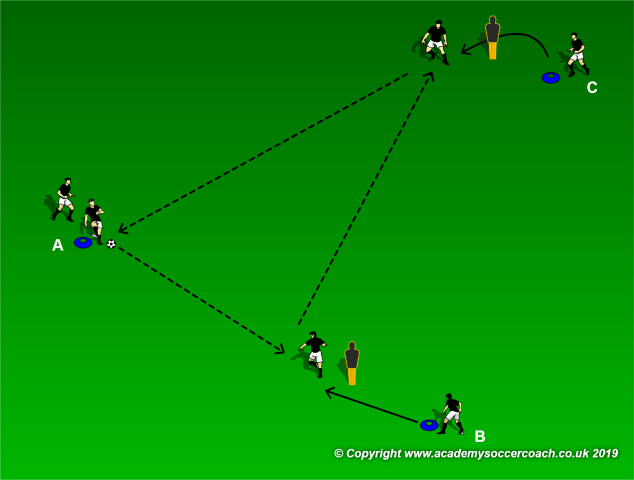
Remind players to focus on: 1) passing quality and 2) adapting an open body stance.
Area: 15 yards by 15 yards.
Players: Two to three players at each position.
Duration: 10 minutes.
Description: Player B comes short to receive a pass from player A. Player B should receive the ball in front of the mannequin with an open body stance. As soon as player B raises his head and there is eye contact with player C, the latter spins around the mannequin to receive a pass from player B. Player C passes to the player at position A (the new player A). Players move one position forward after passing.
Progression: Player A wall-passes with player B prior to passing to player C.
Positional play – 2v2+4 play to the target.
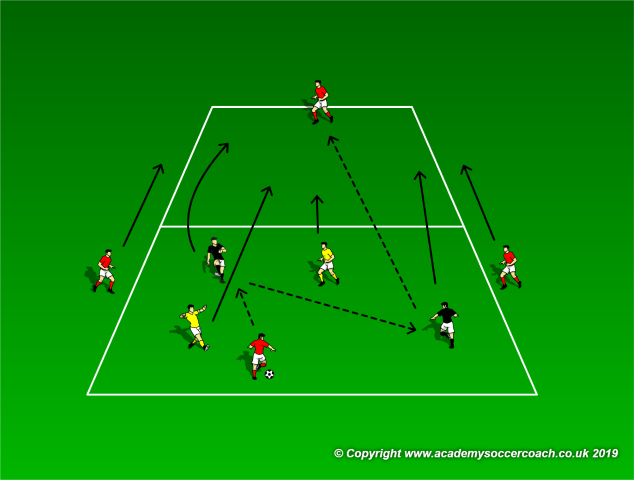
Remind players to focus on: 1) staggered passing angles and 2) adapting an open body stance.
Area: 16 yards in length by 8 yards in width divided into equal horizontal zones.
Players: Two teams of two players plus four neutrals.
Workload: 4 x 2 minutes with 30 seconds rest in between.
Duration: 10 minutes.
Description: Play is 2v2+3 in one zone. The team in possession aims to play the ball to the target player (neutral) in the opposite half of the area. Once this is accomplished the same situation is reversed in the opposite half with one neutral player remaining as a target. Teams must make a string of at least three consecutive passes before playing the ball into the opposite half.
Progressions:
1. The neutral players are not allowed to pass the ball directly to the target player in the opposite side.
2. The side players are not neutral, therefore each team has a player on the perimeter.
Positional play – 3v3+2 support the forward pass.
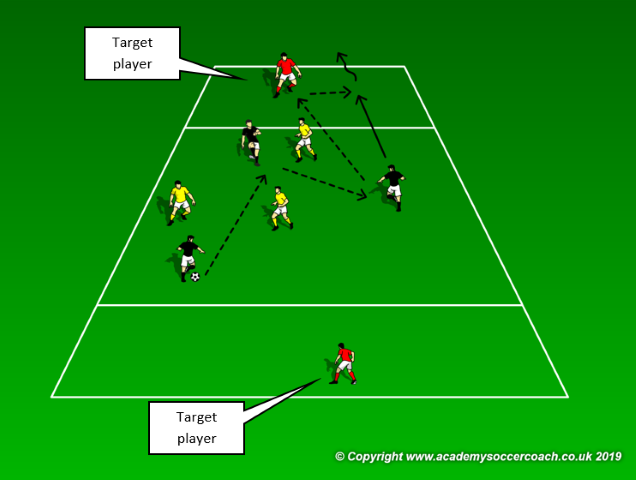
Remind players to focus on: 1) having staggered angles and 2) looking to play vertically.
Area: 35 yards in length by 20 yards in width including two target zones measuring 3 yards in length at each end.
Players: Three players in each team and a target player at each end.
Workload: 2 x 4 minutes with two minutes rest in between.
Duration: 10 minutes.
Description: Directional game where teams try to score by dribbling over the opposition team’s end line after combining with the target player. Teams may use both target players; one to penetrate and the opposite to secure possession of the ball. If the situation is on, the neutral player used to support play may pass directly to the opposite target player.
Progressions:
1. Play 4v4 with no neutral players but with a target player for each team.
2. Encourage mobility where the target player drops and another player takes his position to exploit the created space.
Small sided game – 3v3+2 target players on retracted goals with no goalkeeper.
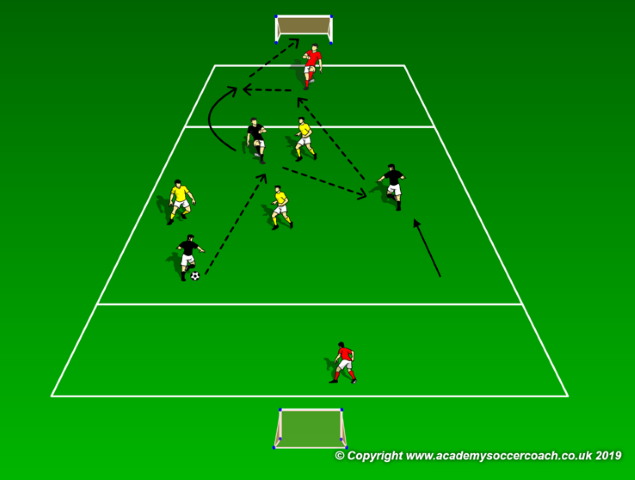
Remind players to focus on: 1) establishing width in attack, 2) looking to play vertically and 3) supporting the vertical pass.
Area: 35 yards in length by 20 yards in width including two target zones measuring three yards in length at each end.
Players: Three players in each team and a neutral target player at each end.
Workload: 4 x 3 minutes with one minute rest in between series.
Duration: 15 minutes.
Description: As in the previous activity but now the attacking team must combine play with the target player prior to finish with a first time shot on goal. If a goal is score after a three player combination, the goal counts double.
Progressions:
1. Play 4v4 with no neutral players but with a target player for each team.
2. Encourage mobility where the target player drops and another player takes his position in order to exploit the space created.
Small sided game – 4v4 on mini goals and goal lines.
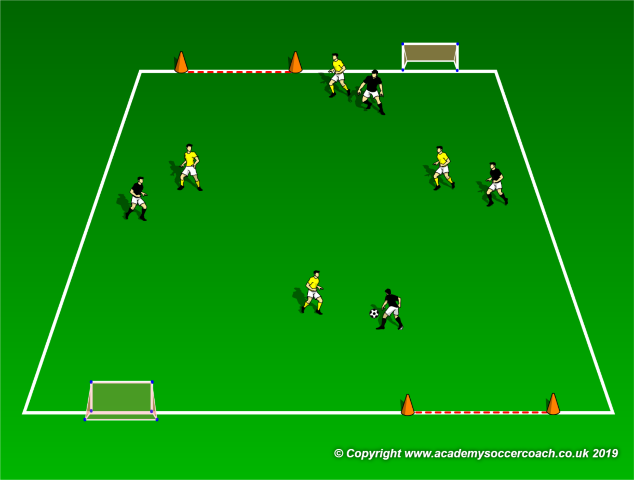
Remind players to focus on: 1) establishing width in attack, 2) looking to play vertically and 3) supporting the vertical pass.
Area: 40 yards in length by 30 yards in width with a mini goal and a five meter goal line at both ends.
Players: Each team is composed of four players and no goalkeepers.
Workload: 2 x 6 minutes with three minutes rest in between.
Duration: 15 minutes.
Description: Each team attacks a goal line five meters in length and a mini goal and defends the opposite two. A goal after combining play with the target player (player giving the team length) counts twice.
Session number: 13.
Moment of the game: In possession.
Team task: Build-up.
Aim: Create and exploit space to build a central attack.
Technical-tactical outcomes:
1. Staggered angles.
2. Have height, depth and length.
3. Off-the-ball movement to open up passing lanes.
4. Look to play vertically.
5. Support the forward pass.
6. Stance to receive and play the ball.
Duration of session: 85 to 90 minutes.
Number of players: 16 outfield players and no goalkeepers.
Equipment:
Bibs – one set of eight.
Markers – to mark pitch dimensions and zones.
Mannequins – two in each setup. These can also be substituted with cones.
Session plan:
1. Movement preparation and coordination: 10 minutes.
2. Technical-tactical activation – Passing angles to play to the target player: 10 minutes.
3. Game 1 – 3v3+2 on four goals on a pitch divided into two horizontal zones: 15 minutes.
4. Game 2 – 3v3+2 on four goals on a pitch divided into four quarters: 15 minutes.
5. Game 3 – 4v4 on four goals: 30 minutes.
6. Conclusion and recapitulation: 5 minutes.
Movement preparation and coordination.
1. Multi directional movement (5 minutes).
2. Dynamic flexibility and mobility (5 minutes).
Technical-tactical activation – Passing angles to play to the target player.
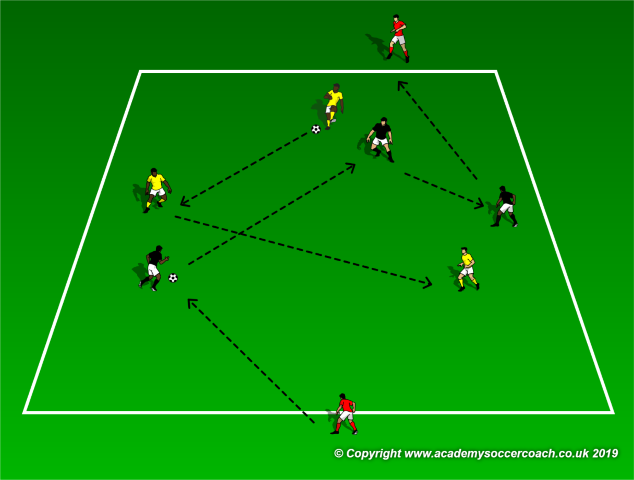
Remind players to focus on: 1) off-the-ball movement, 2) creating a passing angle and 3) adapting an open body stance.
Area: 30 yards in length by 20 yards width.
Players: Three players in each team plus a neutral target player at each end.
Duration: 10 minutes.
Description: Players pass the ball to teammates of the same team to play the ball to the opposite target player. Once a target player receives the ball, the same sequence is restarted in the opposite direction. Rotate target players every two minutes.
Progressions:
1. Players must move to a new angle after passing the ball to a teammate.
2. At least one wall-pass must be included in the sequence.
Game 1 – 3v3 plus two targets.
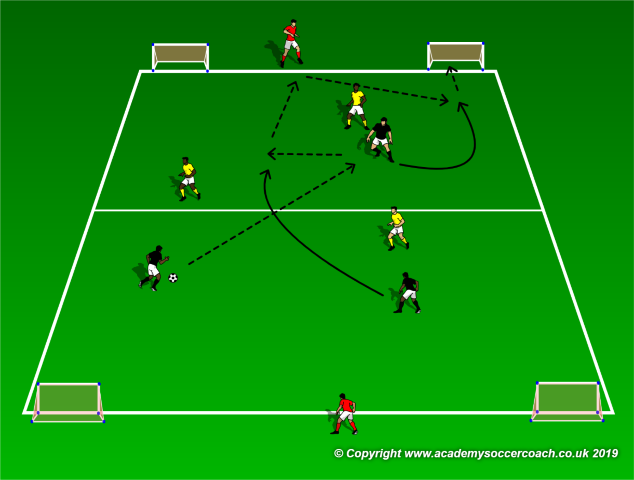
Remind players to focus on: 1) having staggered passing angles, 2) looking to play in verticality and 3) support the vertical pass.
Area: 30 yards in length by 20 yards in width divided into two equal horizontal zones.
Players: Three players in each team plus a neutral target player at each end.
Workload: 4 x 3 minutes with one minute rest in between sets.
Duration: 15 minutes.
Description: Each team defends two mini goals on the same end line and attacks the opposite two. We have one constraint which is that there should be at least a player in every horizontal zone. Players may use the target players to play the vertical ball with them as they are the ones who are giving the team height.
Variation:
We can have two groups; one playing this game and another playing with regular goals but with the same constraints. Players play two sets of this game and then the groups switch games.
Game 2 – 3v3+2 on four goals on a pitch divided into four quarters.
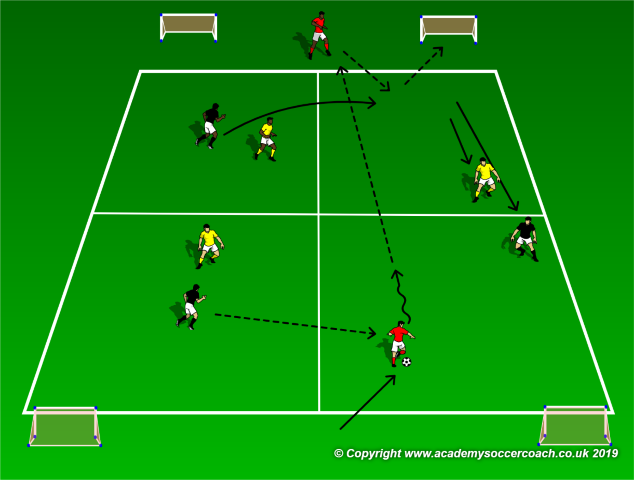
Remind players to focus on: 1) looking to play in verticality and 2) supporting the vertical pass.
Area: 30 yards in length by 20 yards divided into four equal quadrants with two mini goals positioned two meters behind each end line.
Players: Three players each team plus a neutral target player at each end.
Workload: 4 x 3 minutes with one minute rest in between sets.
Duration: 15 minutes.
Description: Same game but with a different constraint. Players can move freely between quadrants and may also rotate positions. However, there cannot be more than two players of the same team in the same quadrant. The neutral player can step out to aid in the build-up of an attack but must return quickly to his place once the ball is played (see above diagram).
Game 3 – 4v4 on four goals.
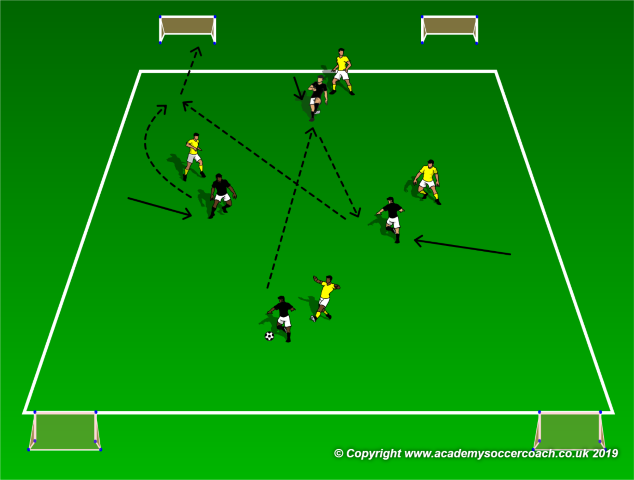
Remind players to focus on: 1) height, depth and length and 2) create passing lanes.
Area: 30 yards in length by 20 yards in width with two mini goals at each side positioned two meters behind each end line.
Players: Four players in each team.
Workload: 4 x 6 minutes with two minutes rest in between sets.
Duration: 30 minutes.
Description: Now we play a 4v4 game with no constraints. To work on the creation of having height, depth and width and to also create passing lanes we can reward with two points a goal scored after a three player combination like the one shown in the above diagram.
Variation:
We can have two groups; one playing this game and another playing with regular goals but with the same constraints. We play two sets of this game and then the groups switch games.
Session number: 14.
Moment of the game: In possession.
Team task: Scoring.
Aim: Create and exploit space in attack to score.
Technical-tactical outcomes:
1. Stance to receive and play the ball.
2. Staggered angles.
3. Have height, depth and length.
4. Off-the-ball movement to open up passing lanes.
5. Look to play vertically.
6. Support the forward pass.
Duration of session: 85 to 90 minutes.
Number of players: 16 outfield players and 2 goalkeepers.
Equipment:
Bibs – one set of eight.
Markers – to mark pitch dimensions and zones.
Balls – at least eight to allow for a better session flow.
Regular goals – at least two; four better to have two setups of each game.
Session plan:
1. Movement preparation and coordination: 10 minutes.
2. Technical-tactical activation – Gate passing combinations 1 and 2: 12 minutes.
3. Speed in attack – 1v1 to score from a through pass: 12 minutes.
4. Game 1 – 4v4+GKs play the through pass: 20 minutes.
5. Game 2 – 4v4+GKs: 20 minutes.
6. Conclusion and recapitulation: 5 minutes.
Movement preparation and coordination.
1. Ball mastery (5 minutes).
2. Dynamic flexibility and mobility (5 minutes).
Technical-tactical activation – Gate passing combination 1.
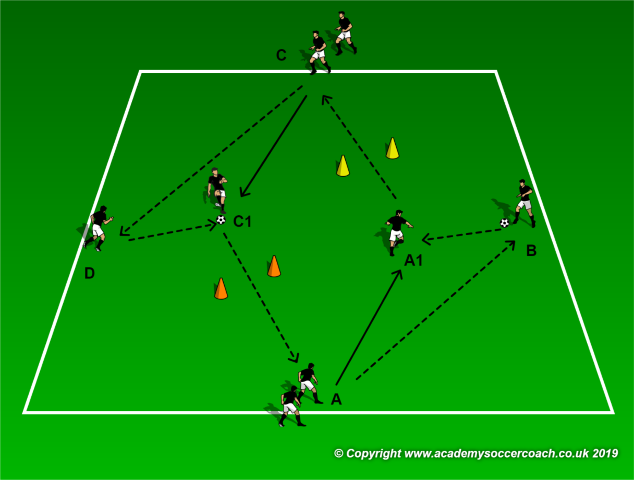
Remind players to focus on: 1) creating passing angles and 2) adapting an open body stance to receive the ball.
Area: 40 yards in length by 30 yards in width.
Players: Two or three players positioned at positions A and C and two players positioned at positions B and D respectively.
Duration: 6 minutes.
Description: Player A passes to player B who returns the ball to player A to pass to player C on the opposite side through the gate. After the sequence is over, player A moves to position B while player B moves to position C. The same sequence is repeated on the opposite side with player C combining with player D who returns the ball to player C to player through the gate to player A. Players move one position forward; player C moves to position D, while player D moves to position A.
Variation: Repeat the same exercise in the opposite direction.
Technical-tactical activation – Gate passing combination 2.
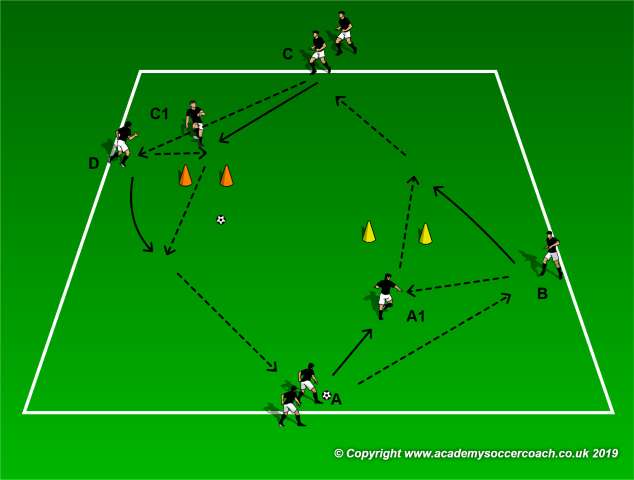
Remind players to focus on: 1) receiving stance and 2) direction and weight of the pass.
Area: 40 yards in length by 30 yards in width.
Players: Two or three players positioned at positions A and C and two players positioned at positions B and D respectively.
Duration: 6 minutes.
Description: Player A combines with player B who lays the ball back to A and spins around to receive the return pass through the gate prior to passing the ball to player C on the opposite side. The same situation is repeated on the opposite side with players C and D.
Variation: Repeat the same exercise in the opposite direction.
Speed in attack – 1v1 to score from a through pass.
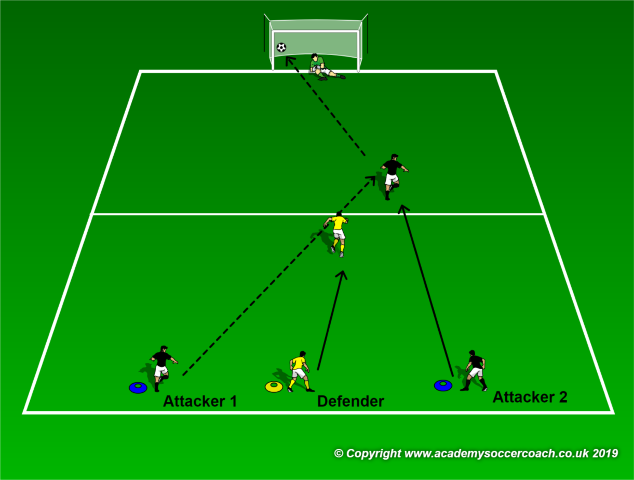
Remind players to focus on: 1) adapting a ready stance to sprint and 2) look forward and focus on the ball.
Area: 40 yards length by 30 yards in width divided into two equal horizontal zones.
Players: Three groups of two attackers and one defender.
Workload: 2 x 6 repetitions – three times as a defender and one time as attacker 2.
Duration: 6 minutes.
Description: Attacker 1 passes in space to attacker 2 to finish on goal while being contrasted by the defender. Players move one position to their right after each repetition. Goals may only be scored from inside the attacking half, and if a goal is scored and the defender is not in the attacking half, the goal counts double. Keep score between two teams to make it more competitive.
Progression: As described above but now we add more pressure on the attackers. Attacker 1 attacks to make the situation a 2v1 but if the shot is off target, the defender scores a point for his team.
Game 1 – 4v4+GKs play the through pass.
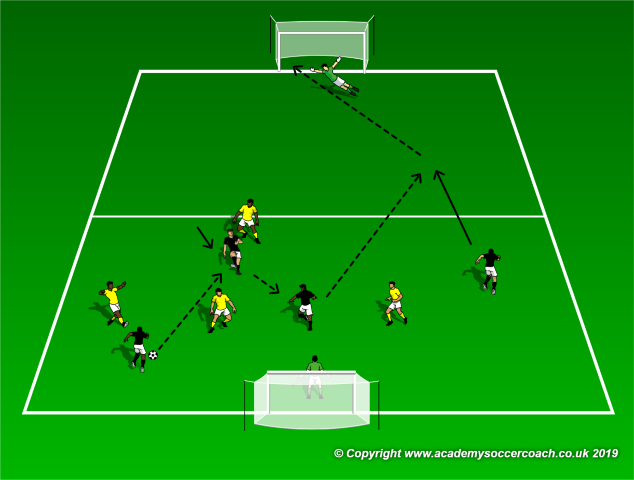
Remind players to focus on: 1) creating passing angles and 2) looking to play forward.
Area: 40 yards in length by 30 yards in width divided into two equal horizontal zones.
Players: Two teams of four outfield players plus a goalkeeper each team.
Workload: 3 x 5 minutes with two minutes rest in between.
Duration: 20 minutes.
Description: Play is in one half of the pitch. To score, the attacking team must play the ball in the other half for another teammate to finish. When this happens, all outfield players must move into this half of the pitch. If a goal is scored or the ball goes out of play, teams reverse roles and the new attacking team aims to attack in the opposite direction in the same way as described before. All restarts take place from the goalkeeper of the team in possession.
Progression: To increase the speed of play, the attacking team must finish at goal in less than a pre-established amount of time, otherwise the opposite team restarts play from their goalkeeper. We might need to reduce the duration to 3 minutes as this progression is more intensive.
Game 2 – 4v4+GKs.
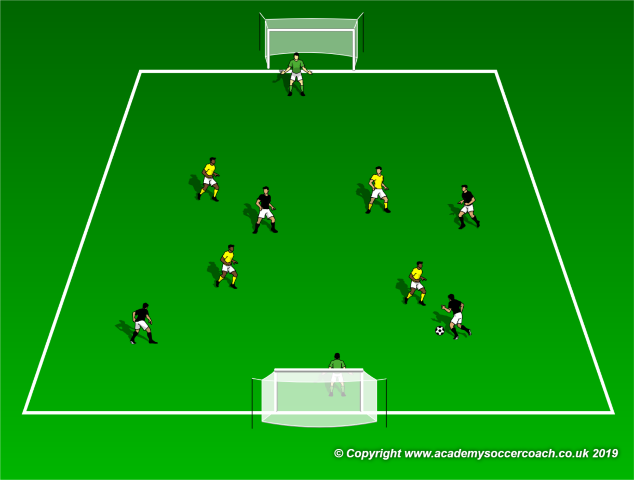
Remind players to focus on: 1) having height, depth and width and 2) creating passing angles.
Area: 40 yards in length by 30 yards in width.
Players: Two teams of four outfield players plus a goalkeeper in goal for each team.
Workload: 3 x 5 minutes with two minutes rest in between.
Duration: 20 minutes.
Description: Normal game but all restarts take place from the goalkeeper of the team in possession. Therefore we work on constructing play from the back with particular emphasis on off-the-ball movement to create passing options.
Progression: Play the third set as follows: A goal counts double if scored in less than six passes.


